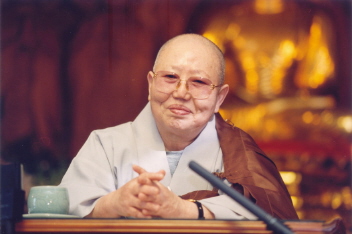My thanks to everyone and anyone who has been reading Buddha Buzz these past few weeks. Because, as we all know, it’s been a bit depressing. Murder, rape, theft, deception—a smorgasbord of horrible activities seems to have hit the Buddhist international community as of late, and I feel somewhat responsible for relaying the information onward to you.
I’m making amends this week. So if you can get through the first story about the perversion of Buddhist teachings and the second story about the passing of a beloved South Korean teacher, I promise you’ll be rewarded with some lovely (and pertinent) photos of puppies.
Here at the Tricycle office we sometimes argue about whether a steady meditation practice naturally brings compassion and ethics. I suppose, though, for our all arguing, that in the end it depends on how you’re practicing meditation. (On a side note, our discourse regarding this issue really suffers from the fact that we generally use the same word—”meditation”—to refer to many different techniques.) As Vishvapani Blomfield writes in a Guardian article this week about how Anders Behring Breivik, the Norwegian responsible for the mass shooting last year at a youth politics camp, used meditation to kill effectively, “the effect of any practice depends on our values.” Blomfield continues,
Meditation makes you calmer and clearer and encourages empathy and kindness … right? Not if you are Anders Behring Breivik who has told psychiatrists that he used meditation to ‘numb the full spectrum of human emotion—happiness to sorrow, despair, hopelessness, and fear.’ He still practises it behind bars to deaden the impact of his actions.
Breivik uses meditation as a form of mind control—a way to focus the mind and exclude responses that get in his way. You could argue that he is meditating wrongly, but I think his testimony shows that the effect of any practice, meditation included, depends on the ends to which it is recruited. Breivik’s aims were determined by his racist beliefs and meditation didn’t challenge them.
Stories like this one are sobering, to say the least. But it’s good to remember sometimes that meditation—and Buddhism, for that matter—is no magic solution.
 I was emailed earlier this week about the passing of Daehaeng Kun Sunim, a female Zen master from South Korea who, at the time of her death at 85 years old, had been ordained for 63 years. Chong Go Sunim has written a lovely tribute to her on his blog “Wake Up and Laugh.” He writes,
I was emailed earlier this week about the passing of Daehaeng Kun Sunim, a female Zen master from South Korea who, at the time of her death at 85 years old, had been ordained for 63 years. Chong Go Sunim has written a lovely tribute to her on his blog “Wake Up and Laugh.” He writes,
She made laypeople a particular focus of her efforts, and broke out of traditional models of spiritual practice to teach in such a way that anyone could practice and awaken. At the same time, she was a major force for the advancement of Bhikkunis (nuns), heavily supporting traditional nuns’ colleges, as well as the modern Bhikkuni council of Korea.
Born in Seoul, Korea, in 1927, she awakened when she was around 7 years old, and spent the years afterwards learning to put her understanding into practice. She would wander the mountains of Korea, wearing a ragged set of clothes and eating only what was at hand. Years later, she said that she wasn’t pursuing some type of asceticism; rather she was just completely absorbed in returning everything to her fundamental Buddha essence, and seeing how that affected what she entrusted.
Our deepest condolences to the students of Venerable Daehaeng. She is the kind of teacher who is so wonderful to hear about—dedicated to Buddhist teachings, exemplary in her behavior, and an inspiration to the people around her.
Now, as promised, the puppies. On Wednesday Tibetan monk Geshe Phelgye gave a pet blessings ceremony at a park in Washington. And the resulting photos were enough to melt even my cynical Buddhist heart. (See all of the photos here.)
Thank you for subscribing to Tricycle! As a nonprofit, we depend on readers like you to keep Buddhist teachings and practices widely available.